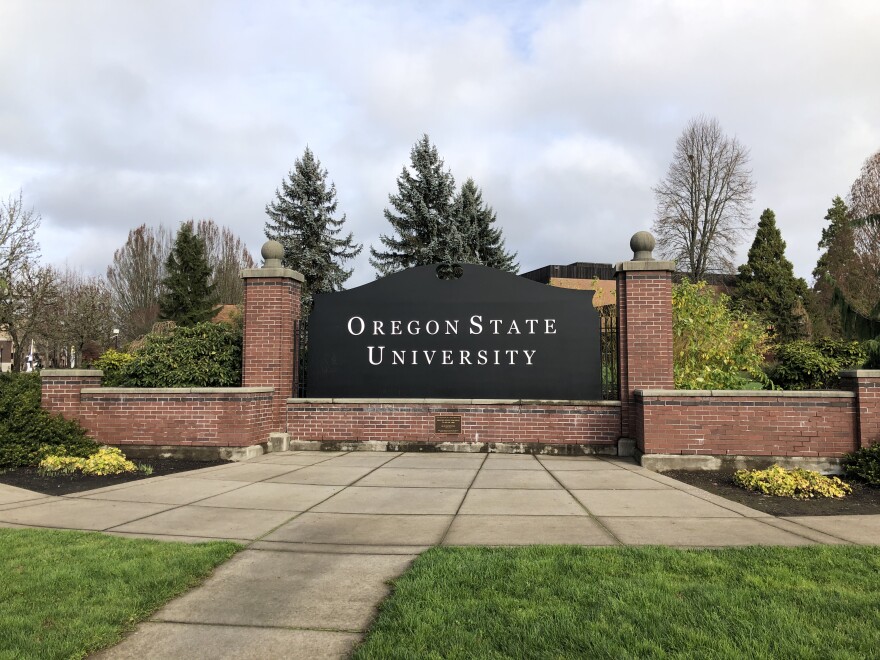
A new research tool analyzes earnings outcomes for graduates of the state's 24 public colleges and universities, including the state's largest university, Oregon State.
Chris Lehman / KLCC
If you’ve ever wondered how much you might’ve earned if you’d only gotten a different degree, or gone to a different college, those numbers just got a lot easier to find for graduates of Oregon institutions.
The Oregon Higher Education Coordinating Commission announced Tuesday a new tool that shows average earnings and job placements for students who have graduated from the state’s public colleges and universities.
The Post-Secondary Employment Outcomes, or PSEO, tool comes from a partnership between the state and the U.S. Census Bureau. Oregon is one of 23 states to partner with the U.S. Census to provide this public data, according to the HECC.
The tool breaks down earnings for graduates from Oregon’s seven public universities and 17 community colleges in increments of one, five and 10 years after graduation. It also breaks down the earnings graduates made with specific degrees.
At the state’s largest university, Oregon State, students who studied computer and information sciences or engineering were the top earners — with both groups seeing more than $100,000 in annual earnings a decade after graduation.
At Portland Community College, the state’s largest community college and largest post-secondary institution of any kind, students who trained in construction saw the highest earnings after graduating — nearly $70,000 in annual earnings five years after graduation.
Among the lowest earners from both schools were graduates who studied general studies and humanities, and visual and performing arts.
“[The tool] will be used for educators and for families and graduates themselves as well as for state policy makers, all to be looking at the kind of places that Oregon graduates go, how many of them remain in the state of Oregon, the kinds of salaries that they make…” Amy Cox, Director of the Office of Research and Data at the HECC, told OPB.
Cox said one of the trends the data shows is that the majority of students graduating from Oregon colleges and universities stay in the state afterward.
It also shows that college graduates’ earnings generally continue to increase years after graduation.
Still, amid rising tuition and student debt, there have been questions about just how necessary a college degree is right now. Colleges and universities in Oregon and across the U.S. have experienced declining enrollment that has only been made worse by the pandemic. Paired with a labor market with a ton of job vacancies, some states are removing degree requirements from job listings.
In Oregon, there has been a downward trend in the percentage of jobs requiring a bachelor’s degree. That was happening even before the pandemic, according to data from the Oregon Employment Department.
Last year, only 5% of job vacancies in Oregon required a bachelor’s degree, according to the employment department. That’s down substantially from 2013, the earliest year data is available, when jobs requiring bachelor’s degrees made up 15% of vacancies.
However, according to the U.S. Bureau of Labor Statistics, earnings tend to track with educational attainment — with people with advanced degrees having higher incomes over their careers.
The new tool developed by states and the Census will help drill down into what financial outcomes tend to result from specific programs at various institutions. Cox, with Oregon HECC, says the tool will be helpful in informing policy makers on how to best support college graduates.
“I think that one of the things that the tool does make clear is the need to support the education — the post-secondary education, the college and university education — of students who are entering fields that are highly needed but may not result in the highest of earnings. So for example, community-strengthening fields like education, teachers and childcare providers, and social service providers,” Cox said.
Cox is hoping the new data set can foster a broader conversation about what it takes to attract people into jobs that may require college degrees, but don’t pay a lot.
“These are fields that we need in all of our communities and we want to support those students, especially so that they’re not burdened with significant debt when they graduate from their program.”
She said Oregon, and the other states in this partnership, are talking with the Census about other filters that might get added to the tool eventually such as race, ethnicity, gender and other student characteristics.
The HECC notes there are limitations to the PSEO tool. The agency says it doesn’t show statewide data and it’s not the most accurate in comparing graduate outcomes between colleges since academic programs differ widely between the schools. The tool also excludes self-employed people as well as people who work at the Department of Defense and the U.S. Postal Service.

